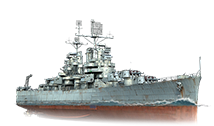| Revision as of 22:14, 20 April 2015 | | Revision as of 22:15, 20 April 2015 Basic information and history provided |
| Line 9: | | Line 9: |
| | 52 light cruisers of this class were originally planned, but nine of them were completed as the light aircraft carriers of the Independence class, and two of them were completed to a somewhat different design, with more compact superstructures and just a single stack. These two were called the Fargo class. Of the 27 Cleveland-class cruisers that were commissioned, one (USS Galveston) was completed as a guided missile cruiser and five were later modified as Galveston and Providence-class guided missile cruisers. Following the naming convention at the time, all the ships completed as cruisers were named for U.S. cities and towns.<br /> | | | 52 light cruisers of this class were originally planned, but nine of them were completed as the light aircraft carriers of the Independence class, and two of them were completed to a somewhat different design, with more compact superstructures and just a single stack. These two were called the Fargo class. Of the 27 Cleveland-class cruisers that were commissioned, one (USS Galveston) was completed as a guided missile cruiser and five were later modified as Galveston and Providence-class guided missile cruisers. Following the naming convention at the time, all the ships completed as cruisers were named for U.S. cities and towns.<br /> |
| | <br /> | | | <br /> |
| ? | Technical drawing of a Cleveland-class cruiser. | | |
| | The Cleveland-class cruisers served mainly in the Pacific Fleet during World War II, especially in the Fast Carrier Task Force, but some of them served off the coasts of Europe and Africa in the U.S. Atlantic Fleet. All of these warships, though hard worked in both the Atlantic and Pacific fleets, and in some cases heavily damaged in combat, survived the war. Except for USS Manchester, which remained in service until 1956, and the guided missile cruisers all of these cruisers were decommissioned by 1950. They suffered from increasing stability problems as anti-aircraft armament and additional radar was added during the war. None were recommissioned for the Korean War, as they required almost as large a crew as the Baltimore-class ships, and those ships were reactivated instead. All non-converted ships were sold off from the reserve fleet for scrapping beginning in 1959. The six that were completed as or converted into guided missile cruisers were reactivated during the 1950s and then served into the 1970s. All particularly the Talos armed ships suffered from greater stability problems, than the original design, due to the extra radar and equipment and top weight, which was particularly severe in USS Galveston, leading to its premature decommissioning in 1970 and USS Oklahoma City and USS Little Rock had to have a large amount of ballast and internal rearrangement to allow continued service in the 1970s. The last of these in service, Oklahoma City, was decommissioned in December 1979. | | | The Cleveland-class cruisers served mainly in the Pacific Fleet during World War II, especially in the Fast Carrier Task Force, but some of them served off the coasts of Europe and Africa in the U.S. Atlantic Fleet. All of these warships, though hard worked in both the Atlantic and Pacific fleets, and in some cases heavily damaged in combat, survived the war. Except for USS Manchester, which remained in service until 1956, and the guided missile cruisers all of these cruisers were decommissioned by 1950. They suffered from increasing stability problems as anti-aircraft armament and additional radar was added during the war. None were recommissioned for the Korean War, as they required almost as large a crew as the Baltimore-class ships, and those ships were reactivated instead. All non-converted ships were sold off from the reserve fleet for scrapping beginning in 1959. The six that were completed as or converted into guided missile cruisers were reactivated during the 1950s and then served into the 1970s. All particularly the Talos armed ships suffered from greater stability problems, than the original design, due to the extra radar and equipment and top weight, which was particularly severe in USS Galveston, leading to its premature decommissioning in 1970 and USS Oklahoma City and USS Little Rock had to have a large amount of ballast and internal rearrangement to allow continued service in the 1970s. The last of these in service, Oklahoma City, was decommissioned in December 1979. |
| | | | | |
Revision as of 22:15, 20 April 2015
This ship was available before the release of Update 0.7.4.
The most numerous class of cruisers ever built, with 52 ships planned and 29 completed. Nine of the uncompleted Cleveland-class cruisers were converted to Independence-class aircraft carriers. The Cleveland design was based on the Helena cruiser. The construction started after the beginning of World War II when the London Naval Treaty limits were removed. Compared with their predecessor, the Cleveland-class cruisers carried heavier AA armament, unusually powerful for their type. Cruisers of this class saw active service in all theaters of World War II. None of them was lost.
The Cleveland-class cruiser is a Tier 6 ship in the U.S.A. cruiser Tech Tree.





